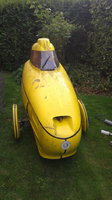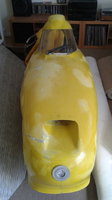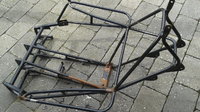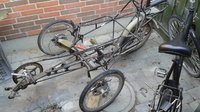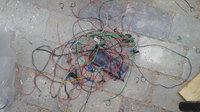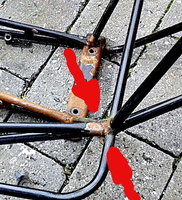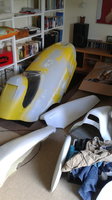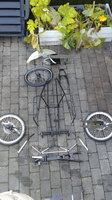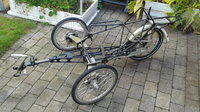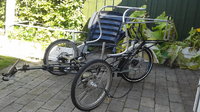Install the app
How to install the app on iOS
Follow along with the video below to see how to install our site as a web app on your home screen.

Anmerkung: This feature currently requires accessing the site using the built-in Safari browser.
Du verwendest einen veralteten Browser. Es ist möglich, dass diese oder andere Websites nicht korrekt angezeigt werden.
Du solltest ein Upgrade durchführen oder einen alternativen Browser verwenden.
Du solltest ein Upgrade durchführen oder einen alternativen Browser verwenden.
Neue alte Leitra
- Ersteller Mikael
- Erstellt am
- Beiträge
- 195
Sorry, English time. 
Fairing getting some putty and a few glasfibre mats. Previous owner rolled over in it, when he had to dodge a kid that suddenly walked in front of him on the bike path.
I'll have to sand all the fairing bits down and paint. Not too keen on the yellow, plus it's faded unevenly. Thinking white mostly with contrast in red or such.
Frame needs some serious love too. Started on it yesterday. I want to strip all the paint and then it gets a rust treatment and Hammerrite.
Model with adjustable bottom bracket, but will fit me where it was. Getting 155 mm crank arms to avoid heels hitting the ground. Was also born with a middrive, but previous owner removed that. Getting a DualDrive rear wheel.
Fairing getting some putty and a few glasfibre mats. Previous owner rolled over in it, when he had to dodge a kid that suddenly walked in front of him on the bike path.
I'll have to sand all the fairing bits down and paint. Not too keen on the yellow, plus it's faded unevenly. Thinking white mostly with contrast in red or such.
Frame needs some serious love too. Started on it yesterday. I want to strip all the paint and then it gets a rust treatment and Hammerrite.
Model with adjustable bottom bracket, but will fit me where it was. Getting 155 mm crank arms to avoid heels hitting the ground. Was also born with a middrive, but previous owner removed that. Getting a DualDrive rear wheel.
Anhänge
Zuletzt bearbeitet:
- Beiträge
- 195
This is my fourth velo. Refurbed a FAW, had a German fairing and then the homemade from my avatar on a Steintrikes Roadshark.
Can tell this was made by an engineer. If there's serious trouble CG's workshop is only 60-70 km away. So far only a somewhat perished spring in the nose coupling.
Pics of naked trike after I removed wiring. And the wiring itself. I have to redo it anyway, as I want 4 direction indicators on the main fairing instead of atop the wheel fairings.
Can tell this was made by an engineer. If there's serious trouble CG's workshop is only 60-70 km away. So far only a somewhat perished spring in the nose coupling.
Pics of naked trike after I removed wiring. And the wiring itself. I have to redo it anyway, as I want 4 direction indicators on the main fairing instead of atop the wheel fairings.
Anhänge
- Beiträge
- 337
Hello Mikael,Sorry, English time.
Fairing getting some putty and a few glasfibre mats. Previous owner rolled over in it, when he had to dodge a kid that suddenly walked in front of him on the bike path.
I'll have to sand all the fairing bits down and paint. Not too keen on the yellow, plus it's faded unevenly. Thinking white mostly with contrast in red or such.
Frame needs some serious love too. Started on it yesterday. I want to strip all the paint and then it gets a rust treatment and Hammerrite.
Model with adjustable bottom bracket, but will fit me where it was. Getting 155 mm crank arms to avoid heels hitting the ground. Was also born with a middrive, but previous owner removed that. Getting a DualDrive rear wheel.
I would prupose to take away the Nylon cover on the frame generously. I did it on my Leitra this way and I found rust underneath the cover for fairly long distances. With a good anti-rust treatment you will have many miles without trouble .
Greetings
Marco
- Beiträge
- 985
I propose a complete stripping by bead blasting, as well as searching for fatigue cracks with a capillary color spray (ink-like color is sucked in cracks by capillary forces, excess color is wiped off, then some white "spray powder" is applied - it sucks the sucked-up color back from the cracks and makes them visible in doing so).
Why do I propose it? Because I think the frame looks bad enough to be suspicious. (pls. see pic)
demonstration of such a spray (better video)
Why do I propose it? Because I think the frame looks bad enough to be suspicious. (pls. see pic)
Anhänge
Zuletzt bearbeitet:
A
Anna T.
Hallo Marco,
Mikaels Bilder vom Rost auf dem Rahmen sind ja wirklich ziemlich ernüchternd. Wie lange dauert es denn, bis man solchen Rost unter der Beschichtung zu erwarten hat?
Mikael's pictures showing the rust on the frame are rather sobering. How long does it take until you have to expect such rust under the coating?
Grüße,
Anna
(...ich übersetze das so (ohne Gewähr): ...)I would prupose to take away the Nylon cover on the frame generously. I did it on my Leitra this way and I found rust underneath the cover for fairly long distances.
Ich würde vorschlagen, die Nylonbeschichtung auf dem Rahmen großzügig zu entfernen. Ich hab das bei meiner Leitra gemacht und auf diese Weise habe ich Rost auf weiten Strecken unter der Beschichtung entdeckt.
Mikaels Bilder vom Rost auf dem Rahmen sind ja wirklich ziemlich ernüchternd. Wie lange dauert es denn, bis man solchen Rost unter der Beschichtung zu erwarten hat?
Mikael's pictures showing the rust on the frame are rather sobering. How long does it take until you have to expect such rust under the coating?
Grüße,
Anna
- Beiträge
- 337
Hallo Anna,
das ist schwer zu sagen, am Anfang merkt man es nicht, die Beschichtung wirkt allenfalls etwas abgehoben..... aber bei mir war es so richtig aufgefallen nach mehreren Wintern mit täglichem Einsatz über 60 bis 70 km. An den Federauflagen für die Hinterradfedern wird die Beschichtung schnell komprimiert und dann sicher auch undicht. Dann zieht es dort Flüsigkeit rein. Das ist eigentlich nicht so gut. Mit reichlich Fett an den empfindlichen Stellen kann man etwas vorbeugen. Da hätte CG Rasmussen vielleicht besser eine Pulverbeschichtung genommen.Man kann natürlich den gesamten Rahmen strippen und neu pulverbeschichten..... aber halt sehr aufwendig aber für Langlebigkeit ein gute Entscheidung.
Grüsse
Marco
das ist schwer zu sagen, am Anfang merkt man es nicht, die Beschichtung wirkt allenfalls etwas abgehoben..... aber bei mir war es so richtig aufgefallen nach mehreren Wintern mit täglichem Einsatz über 60 bis 70 km. An den Federauflagen für die Hinterradfedern wird die Beschichtung schnell komprimiert und dann sicher auch undicht. Dann zieht es dort Flüsigkeit rein. Das ist eigentlich nicht so gut. Mit reichlich Fett an den empfindlichen Stellen kann man etwas vorbeugen. Da hätte CG Rasmussen vielleicht besser eine Pulverbeschichtung genommen.Man kann natürlich den gesamten Rahmen strippen und neu pulverbeschichten..... aber halt sehr aufwendig aber für Langlebigkeit ein gute Entscheidung.
Grüsse
Marco
- Beiträge
- 195
Some pics of the finished frame, plus the painted fairing bits. Main fairing still needs some sanding, but I'm lacking the time due to my studies.
However this is the easiest renovation, I've done. The modular build ensures that. Easy to take apart, simple to reassemble. Same for the fairing parts. Should look brand new, once I'm done.
However this is the easiest renovation, I've done. The modular build ensures that. Easy to take apart, simple to reassemble. Same for the fairing parts. Should look brand new, once I'm done.
Anhänge
A
Anna T.
Hallo Marco, hej Mikael,
Thank you for your precise reply. Do I get this right, the carbone fiber flat springs that the rear wing consists of are mounted directly on the coating, with no interjacent mounting in between?
Grüße,
Anna
[DOUBLEPOST=1479050322][/DOUBLEPOST]Hi Mikael,
These are really nice pictures. Thanks for sharing!
Grüße,
Anna
Danke für die präzise Antwort. Verstehe ich das richtig, die Blattfedern aus Kohlenstoffasern, aus denen die Hinterradschwinge ja besteht, die lagern direkt auf dem Lack, ohne ein Lager dazwischen?An den Federauflagen für die Hinterradfedern wird die Beschichtung schnell komprimiert und dann sicher auch undicht. Dann zieht es dort Flüsigkeit rein. Das ist eigentlich nicht so gut.
Thank you for your precise reply. Do I get this right, the carbone fiber flat springs that the rear wing consists of are mounted directly on the coating, with no interjacent mounting in between?
Grüße,
Anna
[DOUBLEPOST=1479050322][/DOUBLEPOST]Hi Mikael,
Some pics of the finished frame, plus the painted fairing bits. Main fairing still needs some sanding, but I'm lacking the time due to my studies.
These are really nice pictures. Thanks for sharing!
Grüße,
Anna
- Beiträge
- 195
Rear bit is mounted with four bolts on the frame. Dunno why that would be a problem. Last I checked carbon or glassfibre doesn't corrode.  Theres no wear on the carbon.
Theres no wear on the carbon.
If you wanted you could stick washers of your preferred material betwixt frame and rear assembly. But sort of a solution looking for a problem.
Cheers
Mikael
If you wanted you could stick washers of your preferred material betwixt frame and rear assembly. But sort of a solution looking for a problem.
Cheers
Mikael
A
Anna T.
Hi Mikael,
If they are really mounted directly on the coating I do find this problematic - and surprising. Do they really lie directly on the coated frame, over their entire width? On the front wheels too? Please clarify if I misunderstand this.
The carbone fiber flat springs are moving parts - from a technical point of view, one would not design moving parts in a mounting made of lacquer. The lacquer coating has the important function to protect the steel frame from water and thereby from rust, and at same time, it is a substance of limited suitability for standing stress, friction or pressure from moving parts.
Wenn sie wirklich direkt auf dem Lack gelagert sind finde ich das schon problematisch - und überraschend. Liegen sie wirklich direkt auf dem lackierten Rahmen, über ihre ganze Breite? Bei den Vorderrädern auch? Bitte klär mich auf falls ich falsch verstehe.
Die Blattfedern aus Kohlenstofffasern sind bewegliche Teile - aus technischer Sicht würde man bewegliche Teile nicht so entwerfen, dass sie in Lack gelagert sind. Der Lack hat ja die wichtige Funktion, Wasser und somit Rost vom Stahlrahmen zu fernzuhalten, zugleich ist er als Material nur beschränkt geeignet, Belastung, Reibung oder Druck durch bewegliche Teile auszuhalten.
A part that is "sticked" between a moving part and a fixed part is still a moving part and no mounting. That would not be a solution. A mounting would be a part that is fixed and that allows the moving part to move without causing wear or damage to the frame and its coating.
Ein Bauteil, das zwischen ein bewegliches Teil und ein festes Teil "gesteckt" wird, ist immer noch ein bewegliches Teil und kein Lager. Das wäre keine Lösung. Ein Lager wäre etwas, das fest ist, und in dem sich das bewegliche Teil bewegen kann ohne Abnutzung oder Schaden am Rahmen und seinem Lack zu verursachen.
Grüße,
Anna
Rear bit is mounted with four bolts on the frame. Dunno why that would be a problem.
If they are really mounted directly on the coating I do find this problematic - and surprising. Do they really lie directly on the coated frame, over their entire width? On the front wheels too? Please clarify if I misunderstand this.
The carbone fiber flat springs are moving parts - from a technical point of view, one would not design moving parts in a mounting made of lacquer. The lacquer coating has the important function to protect the steel frame from water and thereby from rust, and at same time, it is a substance of limited suitability for standing stress, friction or pressure from moving parts.
Wenn sie wirklich direkt auf dem Lack gelagert sind finde ich das schon problematisch - und überraschend. Liegen sie wirklich direkt auf dem lackierten Rahmen, über ihre ganze Breite? Bei den Vorderrädern auch? Bitte klär mich auf falls ich falsch verstehe.
Die Blattfedern aus Kohlenstofffasern sind bewegliche Teile - aus technischer Sicht würde man bewegliche Teile nicht so entwerfen, dass sie in Lack gelagert sind. Der Lack hat ja die wichtige Funktion, Wasser und somit Rost vom Stahlrahmen zu fernzuhalten, zugleich ist er als Material nur beschränkt geeignet, Belastung, Reibung oder Druck durch bewegliche Teile auszuhalten.
If you wanted you could stick washers of your preferred material betwixt frame and rear assembly.
A part that is "sticked" between a moving part and a fixed part is still a moving part and no mounting. That would not be a solution. A mounting would be a part that is fixed and that allows the moving part to move without causing wear or damage to the frame and its coating.
Ein Bauteil, das zwischen ein bewegliches Teil und ein festes Teil "gesteckt" wird, ist immer noch ein bewegliches Teil und kein Lager. Das wäre keine Lösung. Ein Lager wäre etwas, das fest ist, und in dem sich das bewegliche Teil bewegen kann ohne Abnutzung oder Schaden am Rahmen und seinem Lack zu verursachen.
Grüße,
Anna
Zuletzt bearbeitet von einem Moderator:
- Beiträge
- 337
If this were my heavy duty big size steal frame I restored - I would have added a rear hub Motor at least in order to keep riding seassons fun at any time.
Dual Drive is nice no doubt - but it cant replace a Hub Motor.
Dual Drive is nice no doubt - but it cant replace a Hub Motor.
- Beiträge
- 195
Hi Anna
Rear assembly is mounted under the rear part of the frame with four big bolts. There is not much movement possible there IMHO. If it did move I would have seen rub marks on the spring and there were none. I can take some photos later today.
Again, the rust was not unreasonable for a 10+ year old frame. My trike was much worse... heck, even my upright bike, which is much younger, already looks worse.
Ich_liege_gerne: I might put a motor on it, but I wanted to try it without first. And it's not heavy duty. Should weigh around 28 kg for the whole bike. My homemade weighed 32 and old FAW 2 was 40+. Might go for a bottom bracket motor if need be.
Rear assembly is mounted under the rear part of the frame with four big bolts. There is not much movement possible there IMHO. If it did move I would have seen rub marks on the spring and there were none. I can take some photos later today.
Again, the rust was not unreasonable for a 10+ year old frame. My trike was much worse... heck, even my upright bike, which is much younger, already looks worse.
Ich_liege_gerne: I might put a motor on it, but I wanted to try it without first. And it's not heavy duty. Should weigh around 28 kg for the whole bike. My homemade weighed 32 and old FAW 2 was 40+. Might go for a bottom bracket motor if need be.
Zuletzt bearbeitet:
A
Anna T.
Hi Mikael,
Was rust creeping under the lacquer at this position on your leitra too, like it did on Marco's?
es ist klar dass an dieser Stelle die Bewegung selbst minimal ist. Aber ist es trotzdem ein bewegliches Teil, und Lack ist kein gutes Lager für bewegliche Teile. Wie Marco feststellte, ist es wohl eher Druck als Bewegung, was hier zerstörerisch wirkt. Der Druck an der Kante wo der bewegliche Teil der Feder beginnt muss riesig sein.
Ist der Rost bei Deiner Leitra auch an dieser Stelle unter den Lack gekrochen, wie bei Marcos?
I find these carbone fiber flat springs *not that* convincing. Some time ago, member Sutrai posted this picture in this forum:
Bilder vom Lager der Federn zu sehen würde mich interessieren. Du hast doch welche von vor der Restaurierung? Egal, es ist sowieso immer schön Bilder zu sehen.
Ich finde diese Karbonblattfedern *nicht dermaßen* überzeugend. Vor einiger Zeit hat das Mitglied Sutrai dieses Bild in diesem Forum gepostet:
Und schon wieder: Leitra Bj. 2002

(Foto: Sutrai, in o. g. Beitrag von 2014)
That looks scaring to me, the carbone spring itself an the mounting directly on the lacquer of the frame too.
Für mich sieht das abschreckend aus, die Karbonfeder selbst und die Lagerung direkt auf dem Lack auch.
Grüße!
Anna
it is clear that the movement itself is minimal at this position. But it is still a moving part, and lacquer is no good mounting for moving parts. As Marco stated, it's probably rather pressure than movement which is destructive here. The pressure at the edge where the movable section of the carbon spring begins must be enormous.Rear assembly is mounted under the rear part of the frame with four big bolts. There is not much movement possible there IMHO. If it did move I would have seen rub marks on the spring and there were none.
Was rust creeping under the lacquer at this position on your leitra too, like it did on Marco's?
es ist klar dass an dieser Stelle die Bewegung selbst minimal ist. Aber ist es trotzdem ein bewegliches Teil, und Lack ist kein gutes Lager für bewegliche Teile. Wie Marco feststellte, ist es wohl eher Druck als Bewegung, was hier zerstörerisch wirkt. Der Druck an der Kante wo der bewegliche Teil der Feder beginnt muss riesig sein.
Ist der Rost bei Deiner Leitra auch an dieser Stelle unter den Lack gekrochen, wie bei Marcos?
I'd be interested in seeing pictures of the mounting. You do have some from before restauration? Anyway it's always nice to watch some pictures.I can take some photos later today.
I find these carbone fiber flat springs *not that* convincing. Some time ago, member Sutrai posted this picture in this forum:
Bilder vom Lager der Federn zu sehen würde mich interessieren. Du hast doch welche von vor der Restaurierung? Egal, es ist sowieso immer schön Bilder zu sehen.
Ich finde diese Karbonblattfedern *nicht dermaßen* überzeugend. Vor einiger Zeit hat das Mitglied Sutrai dieses Bild in diesem Forum gepostet:
Und schon wieder: Leitra Bj. 2002
(Foto: Sutrai, in o. g. Beitrag von 2014)
That looks scaring to me, the carbone spring itself an the mounting directly on the lacquer of the frame too.
Für mich sieht das abschreckend aus, die Karbonfeder selbst und die Lagerung direkt auf dem Lack auch.
Grüße!
Anna
- Beiträge
- 337
Hallo,
die Feder auf dem Foto ist defekt, das Querstück an der Auflage scheint heraus gebrochen. An der Auflage ist in der tat wenig Bewegung aber viel Druck, man kann eine Lage Gummi - vom Schlauch- darunter legen, dann wird die Nylonbeschichtung etwas geschont, an den Seiten sollte ordentlich Fett aufgetragen werden, so empfiehlt es der Hersteller.
Grüsse
Marco
die Feder auf dem Foto ist defekt, das Querstück an der Auflage scheint heraus gebrochen. An der Auflage ist in der tat wenig Bewegung aber viel Druck, man kann eine Lage Gummi - vom Schlauch- darunter legen, dann wird die Nylonbeschichtung etwas geschont, an den Seiten sollte ordentlich Fett aufgetragen werden, so empfiehlt es der Hersteller.
Grüsse
Marco

